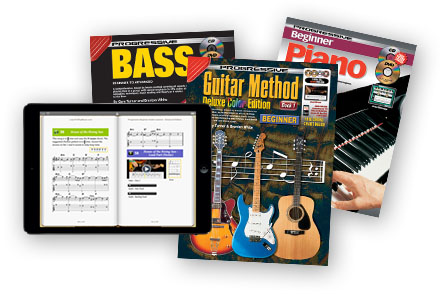One of the most common questions that gets asked by beginners and even some experienced guitarists is the main differences between rhythm guitar and lead guitar. In this post, I am going to explain some of the main differences between the two and the roles each type of guitarist plays while performing as part of a band.
Rhythm Guitar
If you want to play in a band, the ability to play good rhythm guitar is the most essential skill you need to develop. Some bands have two guitarists whose roles are split into lead and rhythm, but it is more common that both players share the roles. In bands with just one guitarist, rhythm playing makes up about two thirds of the guitarists job.
Being a good rhythm guitarist means having a good knowledge of chords and rhythms and being able to lock in with the bass and drums (the rhythm section) and provide a good feel for the vocalist to sing over.
Lead Guitar
The lead guitarist is generally considered to be the most important instrumentalist in a rock/pop group. A group’s ‘sound’ and direction will be influenced by his or her ability and style.
To be a good lead guitarist, you will need to develop the ability to improvise. Improvisation can be defined as being the spontaneous creation of a melody line. That is, when given a rhythm background (i.e. a chord progression) the improvisor is playing a lead melody to blend with it. The improvised lead is spontaneous in that it is not pre-learned (rather, it is done ‘on the spot’), and it is unlikely to ever be repeated in exactly the same way.
Although improvising involves spontaneity and originality, there are certain scales, techniques and ‘licks’ that all Rock guitarists use. Improvising within a song involves special considerations which are not necessary when just ‘jamming’ with a chord progression. These considerations are most important when you reach the stage of forming a repertoire for group performance.
In a song, the lead guitarist does not usually play at the same time as the singer is singing. (When a lead guitarist is not playing lead, they generally play rhythm). Instead he or she may play ‘fill-ins’ in between the singers lines, or play a lead solo during a vocal break. Another common role for the lead guitarist is to play a brief introduction or ending to the song.
An introduction will often involve a short (4 or 8 bars) musical phrase. This ‘riff’ is designed to attract the attention of the listener and help make the song instantly recognizable and memorable. It may be repeated throughout the song (e.g. during the lead break, or at the end of the song). The melody of the introduction is usually played against the chord progression of the song, or some part of it (e.g. it may be based on the chords used in the verses, chorus or bridge). The riff may also ‘borrow’ the melody of either the verses or chorus.
A fill-in is a short lead riff played between one line of the lyric and the next; or between one verse and the next etc. This is the period where the singer usually holds a long note or has a small break. Many of the licks you will learn in this section could be used as a fill-in.
A lead solo involves the lead guitarist playing for a full verse or chorus of the song (or longer), while the singer has a rest. It may occur at the beginning or end of the song, but is more commonly found either half way or two-thirds of the way through the song. The best way to develop your improvising ability is to play with other musicians as much as possible.
If you are jamming with another guitarist, you can take turns at playing lead and rhythm. When you are playing rhythm, listen to the lead player and try to provide a solid base for them to improvise over. When your turn comes to play lead, see if you can use some of the ideas of the other player and alter them to create your own licks.
– Continue learning with us at LearnToPlayMusic.com.






























awesome!! thank u!!
Hey dude!
Great explanation!
I’m just writing a post on my blog about the great guitar player Jim Root, from Slipknot and Stone Sour, and from Wikipedia, I saw that “…Root typically performed lead guitar in Stone Sour, although he sometimes played rhythm…”, and didn’t know the difference beetween this two type of “duties”, but now, I know!
Thnks!
Hey Cristiano, thanks for the feedback. Glad you like the post and found it useful! Feel free to check in on the blog any time, we’ll be sharing several music education posts a week.
Comment…What are the necessary things required of a beginner in guitar playing? What are the things needed of him/her to become a professional in the field?
Hi Hysholad, as a beginner wanting to become a professional you’ll need to practice, practice, practice until your guitar becomes part of you. Once you have the basics under your belt then spend the time listening and learning to play as many styles as possible. Learn to read guitar charts. Join or start bands and play with others as much as you can. And most importantly of all find a professional guitar teacher and mentor who can guide your progress from the start.
Comment…Copy that. Thanks. Is there any recommended song to improve my ability?
You must learn “Smoke on the Water” by Deep Purple and then visit as many guitar shops as you can and play it while testing out all their guitars. Only joking… Seriously, no there is no one recommended song. I would recommend you choose to learn songs that are within your ability at each stage as you progress – don’t try to learn a song that is way too hard when you are starting out as that will destroy your confidence. Also pick songs that you love as that will make practicing much more fun. Again, a teacher can help greatly with this. I would also like to recommend our book “Super Easy Guitar” which you can preview on our webstore here: http://www.learntoplaymusic.com/store/au_en/super-easy-guitar-lessons-notes-chords-rhythms-with-tab-teach-yourself-how-to-play-guitar.html#prettyPhoto
Appreciate the insight. Very well written. Do you think I’m biting off more than I can chew by starting on a 7 string? Ive been goin for 3 months or so and feel good so far. I ve been playing a lot of korn since I like their sound and they play 7 strings. I do feel like its a bit limiting though since most songs I hear are otherwise played on a 6 string. I guess my main question is, do you think Ill be able to play a 6 string ok when the time comes? I do plan on doing so at some point and I’m hopeful that if anything itll make it easier for me since I started with a 7.
Hi Tommy, wow starting on a 7 string is admirable although not something we’d recommend. You see the hardest part of beginning to learn to play guitar or any instrument is putting in the effort for the 1st few months while your brain and fingers learn new pathways. In our experience unless you can get to the point of being able to play something that sounds good reasonably quickly then the motivation quickly disappears… So we’d recommend making things as easy for yourself as possible when your learning. Having said this – you do say you like Korn’s sound so if you’re able to persist to be able to start playing their stuff then this will provide the motivation to keep going. Anything is possible when you love what you’re doing. As far as progressing to a 6 string from a 7 string – we’ll that won’t be any trouble at all – a 7 string is simply a 6 string with 1 extra string.
Just for the record .The Spitfires consisting of Noeline Honter, Maxie Rosairo (vocals) Mohan Sabaratnam ,Drums ,Donald Seneviratne ,Bass Guitar ,Mohan Wimalasuriya ,Keyboards and myself on Tenor Sax played for 3 years in the middle east (Teheran & Damascus ) for 3 years .We had no lead or rhythm guitar though I was an ex lead guitarist .All lead guitar parts were played by the keyboardist on his ARP PRO SOLOIST Monophonic synthesizer . Mohan would play SAMBA PATI on his ARP keyboard and no one would believe it was not on a guitar .
7 string, Korn in 3 months.
I must be doing something wrong. Im into it 4 months. The most complicated piece I know is Neddle and the Damage Done. Keep up the good work!!
Regards,
PS: I’m 64 years young. My brain is not a sponge anymore.
Little harder to retain!!!!
Steve, I know what you mean. I’m 54 and have just started learning since September. I play pretty well for a beginner (I have a lot of musical experience with voice and piano that has helped me greatly), but sometimes I have a hard time remembering the names of chords. Don’t even get me started on what it does to my back!
I am 44 and ive been playing a little over a year. I tend to play a lot on the g,b and low e. Lots of power chords. Several people ive played around in music stores tell me I play like a bassist. Ive never struck a note on a bass and it doesn’t appeal to me. I deel like as i progress and have the rythm of a bassist i can become a good rythm player which is what ive set out to do anyway. Any suggestions?
Hi David, yes it sounds like you have a natural leaning towards rhythm playing – which is great as the rhythm section provides the all important groove of any song. As for “playing like a bassist” well that’s not necessarily a bad thing – given that the bass along with the drums makes up the other important elements of the rhythm section – so you’ll instinctively be able to lock in with what the bass player is doing – especially in riff based music styles like rock and hard rock when bass line and rhythm guitar playing often doubles each other. Having said this, the guitar does have 6 strings and making use of the upper notes available will really fill out the sonic spectrum – especially if there are no other rhythm guitarists or keyboard players in the band. So in your journey to becoming a great rhythm player I’d recommend you add some full chords to your repertoire and experiment with strumming and picking different combinations of stings within these chords while listening to the different harmonies created when playing with a bassist. An easy next step up from playing power chords is to progress to full bar chords (from which power chords are taken). We have a great book and ebook on bar chords available here
do they use the same equipment? how about the equipment set up?
Hi Che, great question and to really do the answer justice – as its such a big topic – we’ll create a whole new post for this. In a nutshell – although both styles of playing can use the same guitars, amps etc – generally guitarists will make different choices of instruments, amps, settings, effects etc to suit either rhythm or lead playing as well as the genre of music they are performing e.g. rock, blues, jazz, reggae etc and even the style of song within that genre e.g. a slow ballad vs an uptempo song. I’d suggest that you work out the style and genre that you are going for and then research players who you really like the sound of and what they play and use in their setups to help you decide what to get. If you’re only just starting out then you’ll do just fine learning and experimenting with both lead and rhythm playing on the same guitar and set-up and you can add from there to develop your sound.
good but is hard to understand
Gr8!!
Well explained!
Just wanted to say a BIG thank you for replying to most of the comments here. I tried to learn Space Oddity by David Bowie for at least 3 months now and I always end up giving up on guitar for a week or more, because that song has hard cords for me. But you’ve motivated me to find easier songs and try to learn them first, so I’m back on track now- playing the guitar
These two types of band positions look similar, but they’re not.
Seems to this non-musician that rhythm guitar is mostly chords and lead quitar is mostly notes.
Hi, I’m Sheu from Zimbabwe. I would like to learn ballad lead guitar but I do not really know where to start. I have tried youtube but those lessons are absurd. I know how to play most of major chords and their minors. Regards.
Hi Sheu, we suggest you check out the PROGRESSIVE COMPLETE LEARN TO PLAY LEAD GUITAR MANUAL. The latest version comes with online audio for every exercise so you can hear how each should sound and then play along when you’re ready.